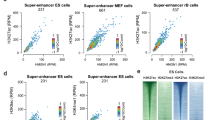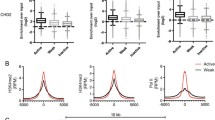Abstract
The homeodomain transcription factor CDP/cut contains four separate DNA binding domains and interacts with large segments of DNA. Thus, CDP/cut has the potential to function as an architectural protein and perhaps to support modifications in chromatin structure and nucleosomal organization. To begin to examine the ability of CDP/cut to interact with chromatin, we analyzed binding of CDP/cut to the histone H4 gene promoter (−90 to +75) reconstituted into nucleosome cores. The −90 to +75 region encompasses the cell cycle regulatory element (Site II) that controls histone H4 gene transcription, a CDP/cut binding site and a nuclease hypersensitive region. Using electrophoretic mobility shift assays and DNase I footprinting experiments, we show that CDP/cut specifically interacts with its recognition motif in a nucleosomal context without displacing the nucleosome core. The competency of CDP/cut to interact with nucleosomes suggests that this transcription factor may facilitate chromatin remodeling in response to cell cycle regulatory and/or developmental cues.
Similar content being viewed by others
References
Piã B, Brüggemeier U & Beato M (1990) Cell 60: 719–731.
Blomquist P, Li Q & Wrange 0 (1996) J. Biol. Chem. 271: 153–159.
Taylor ICA, Workman JL, Schuetz TJ & Kingston RE (1991) Genes Dev. 5: 1285–1298.
Knezetic JA & Luse DS (1986) Cell 45: 95–104.
Workman JL, Taylor IC, Kingston RE & Roeder RG (1991) Methods Cell Biol. 35: 419–47: 419–447.
Lorch Y, LaPointe JW & Kornberg RD (1988) Cell 55: 743–744.
Imbalzano AN, Kwon H, Green MR & Kingston RE (1994) Nature 370: 481–485.
Cote J, Quinn J, Workman JL & Peterson CL (1994) Science 265: 53–60.
Wilson CJ, Chao DM, Imbalzano AN, Schnitzler GR, Kingston RE & Young RA (1996) Cell 84: 235–244.
Owen-Hughes T & Workman JL (1996) EMBO J. 15: 4702–4712.
Wolffe AP (1994) Trends. Biochem. Sci. 19: 240–244.
Struhl K (1996) Cell 84: 179–182.
Brownell JE, Zhou J, Ranalli T, Kobayashi R, Edmondson DG, Roth SY & Allis CD (1996) Cell 84: 843–851.
Ogryzko VV, Schiltz RL, Russanova V, Howard BH & Nakatani Y (1996) Cell 87: 953–959.
Yang WM, Inouye CJ, Zeng Y, Bearss D & Seto E (1996) Proc. Natl. Acad. Sci. USA 93: 12845–12850.
Workman JL & Kingston RE (1992) Science 258: 1780–1784.
Perlmann T & Wrange O (1988) EMBO J. 7: 3073–3079.
Wechsler DS, Papoulas O, Dang CV & Kingston RE. (1994) Mol. Cell. Biol. 14: 4097–4107.
Rhodes D (1985) EMBO J. 4: 3473–3482.
Li B, Adams CC & Workman JL (1994) J. Biol. Chem. 269: 7756–7763.
Barberis A, Superti-Furga G & Busslinger M (1987) Cell 50: 347–359.
van den Ent FM, vanWijnen AJ, Lian JB, Stein JL & Stein GS (1994) J. Cell. Physiol. 159: 515–530.
van Wijnen AJ, van Gurp MF, de Ridder MC, Tufarelli C, Last TJ, Birnbaum M, Vaughan PS, Giordano A, Krek W, Neufeld EJ, Stein JL & Stein GS (1996) Proc. Natl. Acad. Sci. USA 93: 11516–11521.
El-Hodiri HM & Perry M (1995) Mol. Cell Biol. 15: 3587–3596.
Coqueret O, Berube G & Nepveu A (1998) EMBO J 17: 4680–4694.
Lievens PM, Donady JJ, Tufarelli C & Neufeld EJ (1995) J Biol. Chem. 270: 12745–12750.
Skalnik DG, Strauss EC & Orkin SH (1991) J Biol. Chem. 266: 16736–16744.
Dufort D & Nepveu A (1994) Mol. Cell Biol. 14: 4251–4257.
Superti-Furga G, Barberis A, Schaffner G & Busslinger M (1988) EMBO J 7: 3099–3107.
Tufarelli C, Fujiwara Y, Zappulla DC & Neufeld EJ (1998) Dev. Biol. 200: 69–81.
Zeng WR, Scherer SW, Koutsilieris M, Huizenga JJ, Filteau F, Tsui LC & Nepveu A (1997) Oncogene 14: 2355–2365.
Neufeld EJ, Skalnik DG, Lievens PM & Orkin SH (1992) Nat. Genet. 1: 50–55.
Pattison S, Skalnik DG & Roman A (1997) J Virol. 71: 2013–2022.
Aufiero B, Neufeld EJ & Orkin SH. (1994) Proc. Natl. Acad. Sci. USA 91: 7757–7761.
Mailly F, Berube G, Harada R, Mao PL, Phillips S & Nepveu A (1996) Mol. Cell Biol. 16: 5346–5357.
Banan M, Rojas IC, Lee WH, King HL, Harriss JV, Kobayashi R, Webb CF & Gottlieb PD (1997) J. Biol. Chem. 272: 18440–18452.
Pauli U, Chrysogelos S, Nick H, Stein G & Stein J. (1989) Nucl. Acids Res. 17: 2333–2350.
Ramsey-Ewing A, van Wijnen AJ, Stein GS & Stein JL. (1994) Proc. Natl. Acad. Sci. USA 91: 4475–4479.
Holthuis J, Owen TA, van Wijnen AJ, Wright KL, Ramsey-Ewing A, Kennedy MB, Carter R, Cosenza SC, Soprano KJ, Lian JB & et al. (1990) Science 247: 1454–1457.
van Wijnen AJ, Cooper C, Odgren P, Aziz F, De Luca A, Shakoori RA, Giordano A, Quesenberry PJ, Lian JB, Stein GS & Stein JL (1997) J Cell Biochem 66: 512–523.
Last TJ, Birnbaum M, van Wijnen AJ, Stein GS & Stein JL (1998) Gene 221: 267–277.
van Wijnen AJ, Aziz F, Grana X, De Luca A, Desai RK, Jaarsveld K, Last TJ, Soprano K, Giordano A, Lian JB & et al. (1994) Proc. Natl. Acad. Sci. USA 91: 12882–12886.
Aziz F, van Wijnen AJ, Stein JL & Stein GS (1998) J. Cell. Physiol. 177: 453–464.
Harada R, Berube G, Tamplin OJ, Denis-Larose C & Nepveu A (1995) Mol. Cell Biol. 15: 129–140.
Workman JL & Roeder RG. (1987) Cell 51: 613–622.
vanWijnen AJ, van den Ent FM, Lian JB, Stein JL & Stein GS (1992) Mol. Cell. Biol. 12: 3273–3287.
Ausubel FM, B rent R, Kingston RE, Moore DD, Seidman JG, Smith JA & Struhl K. (1989) Current Protocols in Molecular Biology. Greene and Wiley, New York.
Adams CC & Workman JL. (1995) Mol. Cell. Biol. 15: 1405–1421.
Chen H, Li B & Workman JL. (1994) EMBO J. 13: 380–390.
Walter PP, Owen-Hughes TA, Cote J & Workman JL. (1995) Mol. Cell Biol. 15: 6178–6187.
Coqueret O, Martin N, Berube G, Rabbat M, Litchfield DW & Nepveu A (1998) J Biol. Chem. 273: 2561–2566.
Coqueret O, Berube G & Nepveu A. (1996) J Biol. Chem. 271: 24862–24868.
van Wijnen AJ, Ramsey-Ewing AL, Bortell R, Owen TA, Lian JB, Stein JL & Stein GS (1991) J. Cell. Biochem. 46: 174–189.
Felsenfeld G (1992) Nature 335: 219–224.
Getzenberg RH, Pienta KJ, Ward WS & Coffey DS (1991) J. Cell Biochem. 47: 289–299.
Gross DS & Garrard WT (1988) Ann. Rev. Biochem. 57: 159–197.
Stein CA & Cheng YC (1993) Science 261: 1004–1012.
Moreno ML, Pauli U, Chrysogelos S, Stein JL & Stein GS (1988) Biochem. Cell Biol. 66: 132–137.
Chrysogelos S, Pauli U, Stein G & Stein J (1989) J. Biol. Chem. 264: 1232–1237.
Pauli U, Chrysogelos S, Stein J & Stein G (1988) Proc. Natl. Acad. Sci. USA 85: 16–20.
Luo RX, Postigo AA & Dean DC (1998) Cell 92: 463–473.
Author information
Authors and Affiliations
Rights and permissions
About this article
Cite this article
Last, T.J., van Wijnen, A.J., de Ridder, M.C. et al. The homeodomain transcription factor CDP/cut interacts with the cell cycle regulatory element of histone H4 genes packaged into nucleosomes. Mol Biol Rep 26, 185–194 (1999). https://doi.org/10.1023/A:1007058123699
Issue Date:
DOI: https://doi.org/10.1023/A:1007058123699




